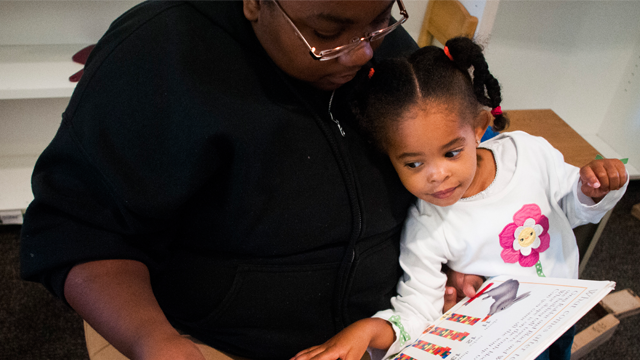This post first appeared at The Nation.

(AP Photo/The Flint Journal, Jake May)
Being a parent is a 24/7 job, so on most days, pretty much everything else is a scheduling conflict. Instead of managing a work-life balance, parents face a steady pile-on of financial pressure and family stresses around the clock.
The White House budget plan tries to fill some of the gaps in parents’ lives, however, by expanding subsidized child care and early learning programs. The budget proposal would “expand access to high-quality care for more than 1.1 million additional children under age four by 2025,” build the child care workforce, provide child care tax credits for higher-income families, extend Head Start school-readiness programs, and promote universal preschool. But while advocates welcome this proposed funding infusion, a conceptual bottleneck remains: the federal spigot tends to switch off once parents pick up their kids from day care — even though their worries follow them home.
That’s why it’s good news that one of Obama’s proposed initiatives reflects how parents’ needs are evolving, by putting forward a program that doesn’t just care for kids while parents are at work. It instead reaches them in their homes — which is often actually when they most need help.
Along with traditional child care centers and preschool classes, Obama wants to expand home visiting services — an initiative already operating in many communities, which combines social work, personalized health care and education for child and adult alike.
Home visitors are typically local social work or health professionals, such as nurses, trained to reach out to households in “high risk” communities suffering from poverty and instability. Through periodic visits, parents are provided with one-on-one guidance on child development and fostering healthy parent-child relationships. Although the programs are voluntary, these consultations are also designed to monitor children’s development and provide acute support if families hit a crisis that requires more intense social services, like mental health treatment.
Home-based services target the many poor parents who are not working or struggling to find a job, and therefore not participating in regular child care programs. “There’s a lot more to going to work than just getting a job,” says Patricia Cole, director of Government Relations of the advocacy group Zero to Three. “And for a family that has multiple risks, multiple stresses, having a little extra help to help you figure out how to organize your own life, how to access mental health services or whatever you need, you’re more likely to go to work.”
One model supported by the Department of Health and Human Services, Parents as Teachers, provides visits about once or twice a month, for the first two years at least, combined with regular meetings with parent groups, “health and developmental screenings for children,” and parent-skill training. Long-term research indicates this approach can help narrow the “achievement gap” between rich and poor kids in kindergarten.
Overall, according to Zero to Three, such programs are associated with gains in “maternal and child health, home and child safety, school readiness, [and] family economic self-sufficiency.”
The home visit concept targets a piece of family policy that’s often overlooked in the child care debate: it’s not just about facilitating a parent’s participation in the workforce. It recognizes that what happens at home, when the parent and child are together, is just as important, if not more so. And supporting families in their communities is often critical for parents dealing with social isolation, instability or financial crisis.
“When you think about early childhood services, it’s kind of a jigsaw puzzle. It has different pieces that fit together,” Cole says, adding that a comprehensive web of services should follow kids from infancy through kindergarten, and be diverse enough to accommodate different parents’ needs: “Especially for infants and toddlers, you do have to find them where they are…some will be at home…some will be in child care.”
The understanding that life’s challenges often intersect and can’t be compartmentalized is at the heart of crafting a community-centered social care system. But the other side of this equation is recognizing the fact that the providers also have families to support. Does the system support them as well?
Nationwide data show that across the early childhood workforce, wages have been largely stagnant for years despite growing public investment in preschool. In addition, income differs sharply according to different student-age groups: the younger the children, the less likely their educator will be earning a living wage even if they have similar credentials. Home visitors and day care workers may be stuck at the bottom of the wage scale as well.
Childhood service workers suffer high turnover rates, chronic stress, low prospects for professional advancement, and a worse experience for the child and worker alike. And not surprisingly, compared to K-12 teachers, early childhood teachers are more likely to be women and people of color, typically with lower levels of education.
Marcy Whitebook, director of the Center for the Study of Child Care Employment, says via e-mail that while she was heartened by Obama’s focus on early childhood, she’s disappointed at the lack of emphasis on improving labor conditions. Throughout the early childhood field, she says via e-mail, “Qualifications have so little to do with pay…. [Pay] is so much driven by sector and age of child.”
Just as economic hardship limits the opportunities and ability of parents to provide care, so the same system poses unjust burdens on the women who do some of the hardest, most under-appreciated work of nurturing and education.
Home visiting is also a modest but meaningful political statement: it’s affirming the centrality of home life in the life of a parent who may be facing countless other stresses in the “outside” world. Subsidized day care and pre-K obviously help, but they are programs designed to fill a schedule slot when parents leave for work in the morning and come back at night. For both care providers and families receiving care, the system fails to support them as whole people and community members, whether they’re in the workforce, attending school, or at home with their kids. Whether they need care — or they need a living wage — the social support infrastructure needs to meet parents where they’re at.


